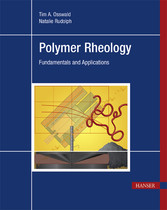Natalie Rudolph, Tim A. Osswald
Polymer Rheology
Fundamentals and Applications
1.Introduction to Rheology
1.1The Field of Rheology
1.2Viscous Liquids or the Newtonian Fluid
1.3Linear Elasticity or the Hookean Spring
1.4Viscoelasticity and the Maxwell Model
1.5Time Scale and the Deborah Number
1.6Deformation, Rate of Deformation and Deviatoric Stress Tensors
1.7Book Guide
2.Structure and Properties of Deforming Polymers
2.1Molecular Structure of Polymers
2.2Stress Relaxation Behavior
2.3Shear Thinning Behavior
2.4Normal Stresses in Shear Flow
2.5Stress Overshoot during Start-up Flow
2.6Melt Strength or Melt Fracture
2.7Dynamic Response
3.Generalized Newtonian Fluid Models (GNF)
3.1Viscosity Temperature Dependence
3.2Viscous Flow Models
3.2.1The Power Law Model
3.2.2The Bird-Carreau-Yasuda Model
3.2.3The Cross-WLF Model
3.2.4The Bingham Model
3.2.5The Herschel Bulkley Model
3.2.6Accounting for Pressure Dependence in Viscous Flow Models
3.3Elongational Viscosity
3.4Suspension Rheology
3.5Chemo-Rheology
4.Transport Phenomena
4.1Dimensionless Groups
4.2Balance Equations
4.2.1The Mass Balance or Continuity Equation
4.2.2The Material or Substantial Derivative
4.2.3The Momentum Balance or Equation of Motion
4.2.4The Energy Balance or Equation of Energy
4.3Model Simplification
4.3.1Reduction in Dimensionality
4.3.2Lubrication Approximation
4.4Viscometric Flows
4.4.1Pressure Driven Flow of a Newtonian Fluid through a Slit
4.4.2Flow of a Power Law Fluid in a Straight Circular Tube (Hagen-Poiseuille Equation)
4.4.3Volumetric Flow Rate of a Power Law Fluid in Axial Annular Flow
4.4.4Circular Annular Couette Flow of a Power-Law Fluid
4.4.5Squeezing flow of a Newtownian Fluid between Two Parallel Circular Discs
4.4.6Flow of a Power-Law Fluid Between Two Parallel Circular Discs
5.Viscoelasticity
5.1Linear Viscoelasticity
5.1.1Relaxation Modulus
5.1.2The Boltzmann Superposition Principle
5.1.3The Maxwell Model - Relaxation
5.1.4Kelvin Model
5.1.5Jeffreys Model
5.1.6Standard Linear Solid Model
5.1.7The Generalized Maxwell Model
5.1.8Dynamic Tests
5.2Non-Linear Viscoelasticity
5.2.1Objectivity
5.2.2Differential Viscoelastic Models
5.2.3Integral Viscoelastic Models
6.Rheometry
6.1The Sliding Plate Rheometer
6.2The Cone-Plate-Rheometer
6.3The Parallel-Plate Rheometer
6.4The Capillary Rheometer
6.4.1Computing Viscisty
6.4.2Viscosity Approximation
6.5 The Melt Flow INdexer
6.6 Extensional Rheometry
6.7 High Pressure Rheometers
6.8 Integrated Mold Sensors1Introduction
© 2009-2024 ciando GmbH
 Zu Hanser-Fachbuch.de
Zu Hanser-Fachbuch.de
 Warenkorb
Warenkorb
